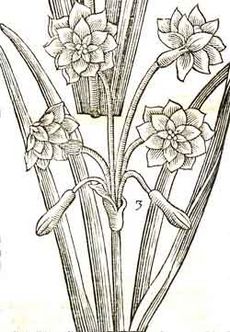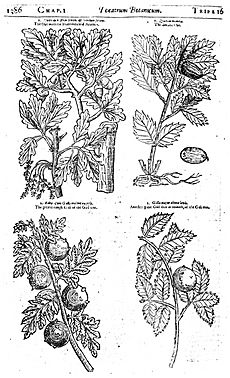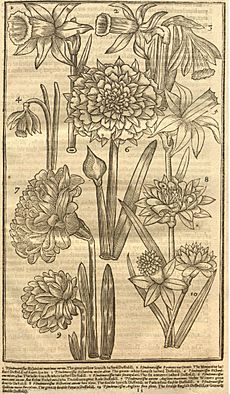John Parkinson (botanist) facts for kids
Quick facts for kids
John Parkinson
|
|
|---|---|

An engraving of Parkinson from his monumental work Theatrum Botanicum (1640), reprinted in Agnes Arber's Herbals (1912).
|
|
| Born | 1567 |
| Died | Summer 1650 (aged 82–83)
|
| Nationality | English |
| Known for | Publishing Paradisi in Sole, Paradisus Terrestris (1629) and Theatrum Botanicum (1640) |
| Scientific career | |
| Fields | Herbalism and botany |
John Parkinson (1567–1650) was a famous English herbalist and one of the first great botanists. He worked as an apothecary (someone who prepared and sold medicines) for King James I. He also helped start the Worshipful Society of Apothecaries in 1617. Later, he became the Royal Botanist for King Charles I.
Parkinson is well-known for two very important books. The first was Paradisi in Sole Paradisus Terrestris (1629), which means Park-in-Sun's Terrestrial Paradise. This book taught people how to grow plants properly. His second book was Theatrum Botanicum (1640), or The Botanical Theatre. It was the most complete and beautifully presented book about plants in England at that time. John Parkinson was also a top gardener. He had his own botanical garden in Long Acre, London, near where Trafalgar Square is today. He was friends with many other important plant experts in England and Europe.
Life of John Parkinson
John Parkinson was born in 1567 and grew up in Yorkshire, England. When he was 14, he moved to London to become an apprentice apothecary. This meant he learned how to prepare and sell medicines.
He worked hard and eventually became the apothecary for King James I. In 1617, he helped create the Worshipful Society of Apothecaries. He also helped the Society get its official coat of arms. He was part of the team that published the Pharmacopœia Londinensis in 1618. This was a book of official rules for making medicines in London.
Later, he became the botanist for King Charles I. A writer named Anna Parkinson, who is a distant relative, says that in 1625, when King Charles I's wife, Henrietta Maria of France, came to England at age 15, John Parkinson helped her learn about gardening.
In 1629, Parkinson wrote his first big book, Paradisi in Sole Paradisus Terrestris. The title was a clever play on his name, "Park-in-Sun." He dedicated this book, which he called his "Speaking Garden," to Queen Henrietta Maria. This book was the first important guide to gardening published in England. It gave a great look at English gardens in the early 1600s.
Parkinson loved finding new plants. He got plants from his friends abroad and even paid for an expedition to Spain and North Africa in 1607–1608. He brought seven new plants to England. He was also the first gardener in England to grow the large double yellow Spanish daffodil. He wrote that he had never seen this type of daffodil before 1618, and he grew it himself in his garden.
Parkinson was a Roman Catholic. In his book Paradisi in Sole, he wrote that he saw plants as a sign of God's creation. He believed that gardens could help people feel a bit of the Garden of Eden. However, during his time, there were struggles between Protestants and Catholics. This meant Parkinson had to be careful and keep a low profile. The English Civil War (1642–1651) also caused problems for his family.

Parkinson lived in London, but his botanical garden was in Covent Garden, an area known for market gardens. Today, this area is close to Trafalgar Square. We don't know much about his garden, but it was likely about 2 acres in size and surrounded by a wall. He grew 484 different types of plants there.
Parkinson was considered one of the best gardeners of his time. He kept in touch with other important botanists and plant experts from England and Europe. These included John Gerard, John Tradescant the elder, and Matthias de Lobel. They were all part of a generation that saw many new and exciting plants arriving from places like the Levant (Middle East) and Virginia (North America).
John Parkinson passed away in the summer of 1650 and was buried on August 6 at St Martin-in-the-Fields in London. A group of leguminous trees from Central America, called Parkinsonia, is named after him. His book Paradisi in Sole also inspired a children's story called Mary's Meadow by Juliana Horatia Ewing. In the story, children read Parkinson's book and are inspired to create their own garden. This led to the creation of the Parkinson Society, which aimed to find and grow old garden flowers, exchange seeds, and protect rare wild flowers.
John Parkinson's Books
Parkinson's first major book, Paradisi in Sole Paradisus Terrestris, was published in 1629. It taught people how to grow plants in three main parts: the flower garden, the kitchen garden, and the orchard garden. The book didn't give specific instructions for every plant. Instead, it offered general advice on how to set up a garden, prepare the soil, graft plants, and what types of plants to include.
The book featured illustrations of almost 800 plants on 108 full pages. Most of these pictures were original woodcuts made by a Swiss artist named Christopher Switzer. Some pictures were copied from other famous botanists' works.

In Paradisi in Sole, Parkinson mentioned he hoped to add a fourth section about medicinal herbs. He kept this promise in his other huge book, Theatrum Botanicum (The Botanical Theatre), which he published in 1640 when he was 73 years old. This book was delayed because another popular plant book by Thomas Johnson was released around the same time.
Theatrum Botanicum was a massive book with 1,688 pages. It described over 3,800 plants and was the most complete and beautifully presented English book on plants of its time. It was the first book to describe 33 native English plants. Some of these plants, like the Welsh poppy and the Strawberry Tree, were common but had never been officially recorded before. Parkinson wanted this book to be a reliable guide for apothecaries, and it was used for over a hundred years after his death. He gave a copy of the book to King Charles I, who then gave him the title "Botanicus Regis Primarius" ("Royal Botanist of the First Rank").
Published Works

- Paradisi in Sole Paradisus Terrestris (1629)
- Theatrum Botanicum (1640)
Gallery
-
John Parkinson marble by Léon-Joseph Chavalliaud (1899), outside the Palm House at Sefton Park, Liverpool



